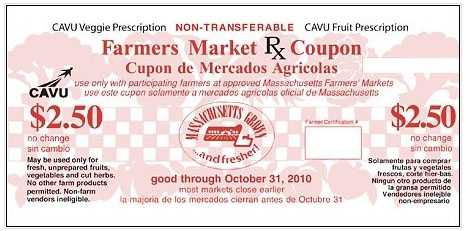In 2007, Chef Michel Nischan and Gus Schumacher founded Wholesome Wave, a non-profit aimed at getting healthy fresh and locally grown food into the hands of America’s most needy while simultaneously stimulating local food economies and shifting the balance towards more localized food systems.
Their first program, the Double Value Coupon Program, doubles the value of SNAP credits (Supplement Assistance Nutrition Program - otherwise known as foodstamps) when they are used at farmer’s markets.
The program has been a huge success, and Nischan believes that the quality of produce found at farmer’s markets is 90% responsible. In a recent interview with Utne Reader, he explained, “It’s not that folks in these communities maybe want the access, they’re desperate for it, they just can’t afford it. When [markets] provide affordability with something as simple as a two-for-one sale, they come in droves and they continue to come after the benefit is gone.”
The Double Value Coupon Program is now at 400 farmers markets nationwide supporting local farmers, circulating money in local economies and providing healthier food to under served communities.
According to a report on their website, the 2011 success of the program is palpable:
- In 2011, nearly 39,000 DVCP consumers purchased fresh, healthy produce from local farmers at partnering farm-to-retail venues, an increase from 20,000 participants in 2010.
- 86% of DVCP consumers reported they ate more fresh fruits and vegetables and more than 90% said the amount of fresh foods they bought at the market made a big difference in their family’s diet.
- On average, ¼ of total market sales at participating farm-to-retail venues were from DVCP consumers.
- In response to increased sales, farmers expanded acreage/production, diversified products and added additional hoop houses or greenhouses.
Other programs supported by Wholesome Wave are the Fruit and Vegetable Prescription Program and the Healthy Food Commerce Investments.
The Fruit and Vegetable Prescription Program targets overweight and obese children as well as pregnant women at risk for developing food related preventable diseases like type 2 diabetes. With health care providers and farmers market partners, they identify candidates for the program.
Once enrolled, each participant has a weekly meeting with a primary care provider and a nutritionist to learn about healthy eating habits. After each visit, the participant will get a prescription for fruits and vegetables that they should buy at the next farmers market.
The prescription is worth $1 per day per family member, so for example a family of 4 would receive $28 per week, and is only redeemable at a participating farmers market.

Boston based doctor Shikha Anand helped to develop the prescription program. She told the Washington Post, “We talk a lot about health in a holistic sense, but we haven’t been empowered to endorse it in any way. I could write prescriptions all day long for amoxicillin. But I couldn’t prescribe a tomato.”
The Healthy Food Commerce Investments initiative works to direct capital and business development assistance to ‘healthy food hubs.’ These hubs are centrally located facilities that facilitate the “aggregation, storage, processing, distribution, and marketing of regionally produced food products.”
The mission of Healthy Food Commerce Investments: “It is our goal to help the channels for “local food” expand so regional farms can more reliably, safely and efficiently source product to institutional buyers like hospitals, schools and large dining outlets. While retail demand for locally grown food has exploded, consistent and simple local sourcing remains problematic for institutional buyers, partly due to challenges with logistics & distribution and marketing.”
With all of these innovative programs in the works, it’s easy to see why some call Michel Nischan a sustainable food pioneer. To really make our food systems in America more resilient, we will need to simultaneously address the issues of increasing food production, increasing the efficiency of food systems (and/or the distance from farm to table with programs like these at Wholesome Wave), and decreasing food waste all along the production and consumption stream.
